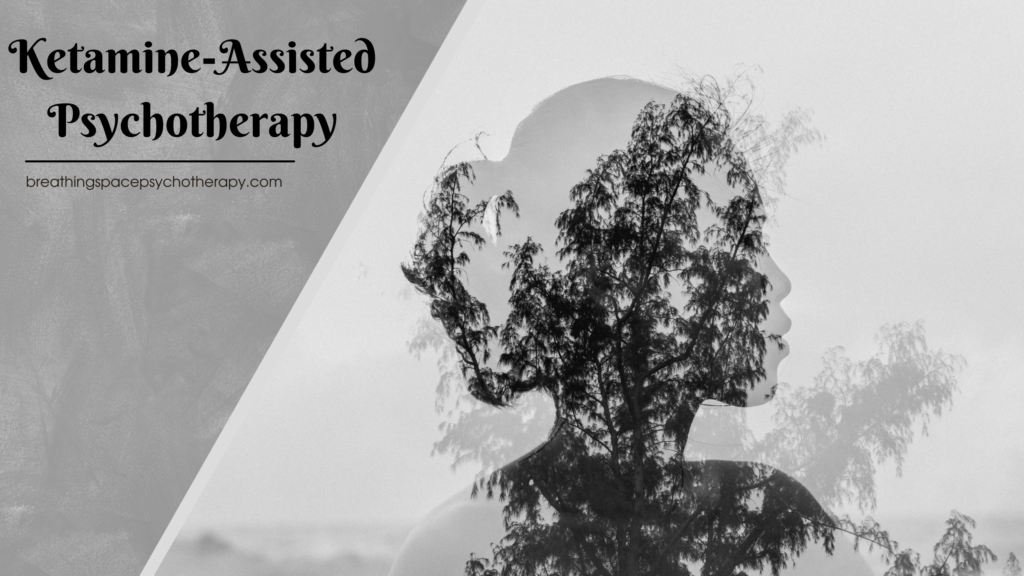Ketamine is a medication that was FDA-approved as an anesthetic in the 1970s. It is used in hospitals for surgeries and other medical procedures and has been shown to be a physically safe anesthetic because it doesn’t suppress breathing. Ketamine also has analgesic (pain control) properties and dissociative effects that help people go through surgeries. Recently, ketamine has garnered more attention as researchers study ketamine’s antidepressant effects.
In 2019, the Food and Drug Administration (FDA) approved esketamine, a nasal spray called Spravato, used for treatment-resistant depression. Ketamine has yet to be approved by the FDA but is still used as a fast-acting antidepressant, treating symptoms of treatment-resistant depression.

Ketamine-Assisted Psychotherapy (KAP) is a mental health treatment method that prescribes the medication ketamine alongside psychotherapy to help individuals work through emotional and mental challenges.
In KAP, ketamine is delivered in subanesthetic doses—enough of a dose to induce trance-like states but not enough to put you under.
Ketamine can be administered in 5 forms:
-
- Intravenous: ketamine is delivered into the veins via a needle.
- Intramuscular: ketamine is delivered into the muscle via a needle.
- Intranasal: ketamine is delivered through the nose using a nasal spray.
- Sublingual: a ketamine tablet is placed under the tongue to dissolve and be absorbed into the bloodstream. This is the method used at Breathing Space Psychotherapy.
- Oral Capsule: ketamine capsule is swallowed.
How does ketamine work?
The most commonly known form of antidepressants is SSRIs or SNRIs. SSRIs and SNRIs work on monoamines: serotonin, dopamine, and norepinephrine. Ketamine, on the other hand, works on a different pathway: the glutamate system. Ketamine blocks NMDA receptors in the glutamate system, which can produce antidepressant effects. Glutamate plays a key role in mood regulation. Simply put, Ketamine acts on neurotransmitters in the brain to bring about a range of effects such as dissociation, altered perceptions, and pain relief.
Researchers hypothesize that ketamine facilitates neuroplasticity, providing an opportunity to boost learning in cognitive and behavioral therapeutic interventions. We learn and grow most easily when our brain is in a plastic state. Ketamine is thought to achieve this.
Ketamine has been shown to help with rapid relief from depression, reduce symptoms of anxiety, improve PTSD symptoms, and increase focus and creativity. In treating substance use disorders, ketamine may reduce cravings and increase motivation to quit.
What ketamine can’t do
Ketamine is not a quick fix or a magical cure-all.
While ketamine is a fast-acting agent, the effects are short-lived. Some individuals may experience ketamine’s effects for a couple of weeks, then experience a relapse, while others may take months before a relapse. Some changes are lasting.
A critical part of KAP is integration. We use the time when the brain is in its most plastic state to work on new habits, introduce new thought patterns, or learn new ways of looking at the world.
Common Side Effects of Ketamine
Common side effects of ketamine include:
-
- Dizziness,
-
- Nausea,
-
- Persistent dissociative symptoms or feeling like you’re “floating”,
-
- Confusion,
-
- Drowsiness,
-
- Double vision.
Is Ketamine-Assisted Psychotherapy effective?
Research suggests that adjunctive psychotherapy may prolong the positive effects of ketamine.
For example, when used in combination with KAP, experiential therapies can help patients to integrate and process their ketamine experiences in a more meaningful and lasting way.
Experiential therapies are types of therapy that involve engaging in activities or experiences to promote emotional and psychological healing. These may include things like art therapy, music therapy, mindfulness practices, or even activities like hiking or kayaking.
Thus, a patient who has had a transformative experience during a KAP session may benefit from art therapy or other creative activities to help them explore and express their emotions. Utilizing both together can extend the benefit, sometimes offering lasting change.
